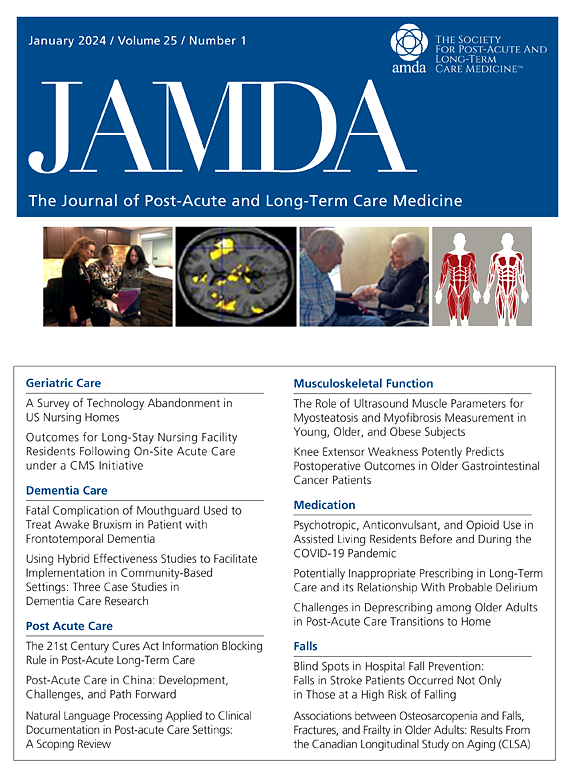在医疗紧急情况下护理长期护理居民的更好方法:使用楔形设计来减少不必要的急性护理转移的实施干预。
IF 3.8
2区 医学
Q2 GERIATRICS & GERONTOLOGY
Journal of the American Medical Directors Association
Pub Date : 2025-06-18
DOI:10.1016/j.jamda.2025.105716
引用次数: 0
摘要
目的:大约25%的长期护理(LTC)居民在经历急性健康状况变化时被转移到急诊科(ED)。这可能对医疗资源造成压力,并对居民产生负面影响。如果提供适当的支持,许多居民的情况可以在长期服务中心内得到管理。本实施研究的目的是优化和评估LTC住院患者在考虑急性护理管理和转院决策时遵循的流程。设计:采用随机楔形设计来实施标准化的ltc - ed护理和转诊途径,并由2个INTERACT工具提供支持。该路径每3个月在9组(4-5)LTC设施中实施一次,并由实施教练提供支持。实施战略考虑了当地长期疟疾的情况和障碍,以及与大流行病有关的挑战。地点和参与者:加拿大卡尔加里的40个LTC设施和4个ed。方法:主要观察指标为LTC向ED转移的变化;次要结果包括住院、LTC和ED医生之间便利电话咨询的使用以及社区护理人员的访问。分析使用负二项回归来估计发病率(每1000名居民),同时调整不同的队列。使用单位成本分析进行了经济评价。结果:干预降低了ltc到ed转移的发生率(干预后1.70 vs干预前1.91;P < 0.001),住院率降低(0.94 vs 1.08;P < 0.001)。医学博士之间便利电话咨询的使用有所增加,但社区护理人员的访问没有增加。这项干预措施在实施后评估期间为卫生保健系统节省了790万加元。结论和意义:实施标准化的LTC到急诊科护理和转诊途径似乎减少了LTC居民的急诊科转移和住院,同时实现了医疗保健系统的成本节约。减少从LTC到急诊科的不必要转移,转而关注LTC内急性医疗问题的早期识别和管理,这似乎是一种可行的、以患者为中心的、资源优化的护理方法。本文章由计算机程序翻译,如有差异,请以英文原文为准。
A Better Way to Care for Long-Term Care Residents in Times of Medical Urgency: An Implementation Intervention Using a Stepped-Wedge Design to Reduce Unnecessary Acute Care Transfers
Objective
Approximately 25% of long-term care (LTC) residents are transferred to an emergency department (ED) when experiencing an acute change in health status. This can place strain on health care resources and negatively impact residents. Many residents’ conditions could be managed within LTC if appropriate supports were provided. This implementation study objective was to optimize and evaluate processes followed when considering acute care management and transfer decisions for residents in LTC.
Design
A randomized stepped-wedge design was used to implement a standardized LTC-to-ED care and referral pathway, supported by 2 INTERACT tools. The pathway was implemented within 9 cohorts of (4-5) LTC facilities every 3 months, supported by an implementation coach. Implementation strategies considered local LTC context and barriers, as well as pandemic-related challenges.
Setting and Participants
40 LTC facilities and 4 EDs within Calgary, Canada.
Methods
The primary outcome was change in transfers from LTC to ED; secondary outcomes included hospital admissions, use of facilitated telephone consultation between LTC and ED physicians, and community paramedic visits. Analysis used negative binomial regression to estimate the incident rate (per 1000 residents), while adjusting for the different cohorts. An economic evaluation was conducted using a unit cost analysis.
Results
A reduction in the incident rate of LTC-to-ED transfers was observed with the intervention (1.70 postintervention vs 1.91 preintervention; P < .001), along with reduction in hospital admission (0.94 vs 1.08; P < .001). There was an increase in use of facilitated telephone consultations between MDs but no increase in community paramedic visits. The intervention saved the health care system CAD$7.9 million over the postimplementation evaluation period.
Conclusion and Implications
Implementation of a standardized LTC-to-ED care and referral pathway appears to reduce ED transfers and hospitalizations among LTC residents, while realizing cost savings to the health care system. Reducing unnecessary transfers from LTC to ED, and instead focusing on earlier identification and management of acute medical issues within LTC, looks to be a feasible, patient-centered, and resource-optimized approach to care.
求助全文
通过发布文献求助,成功后即可免费获取论文全文。
去求助
来源期刊
CiteScore
11.10
自引率
6.60%
发文量
472
审稿时长
44 days
期刊介绍:
JAMDA, the official journal of AMDA - The Society for Post-Acute and Long-Term Care Medicine, is a leading peer-reviewed publication that offers practical information and research geared towards healthcare professionals in the post-acute and long-term care fields. It is also a valuable resource for policy-makers, organizational leaders, educators, and advocates.
The journal provides essential information for various healthcare professionals such as medical directors, attending physicians, nurses, consultant pharmacists, geriatric psychiatrists, nurse practitioners, physician assistants, physical and occupational therapists, social workers, and others involved in providing, overseeing, and promoting quality

 求助内容:
求助内容: 应助结果提醒方式:
应助结果提醒方式:


